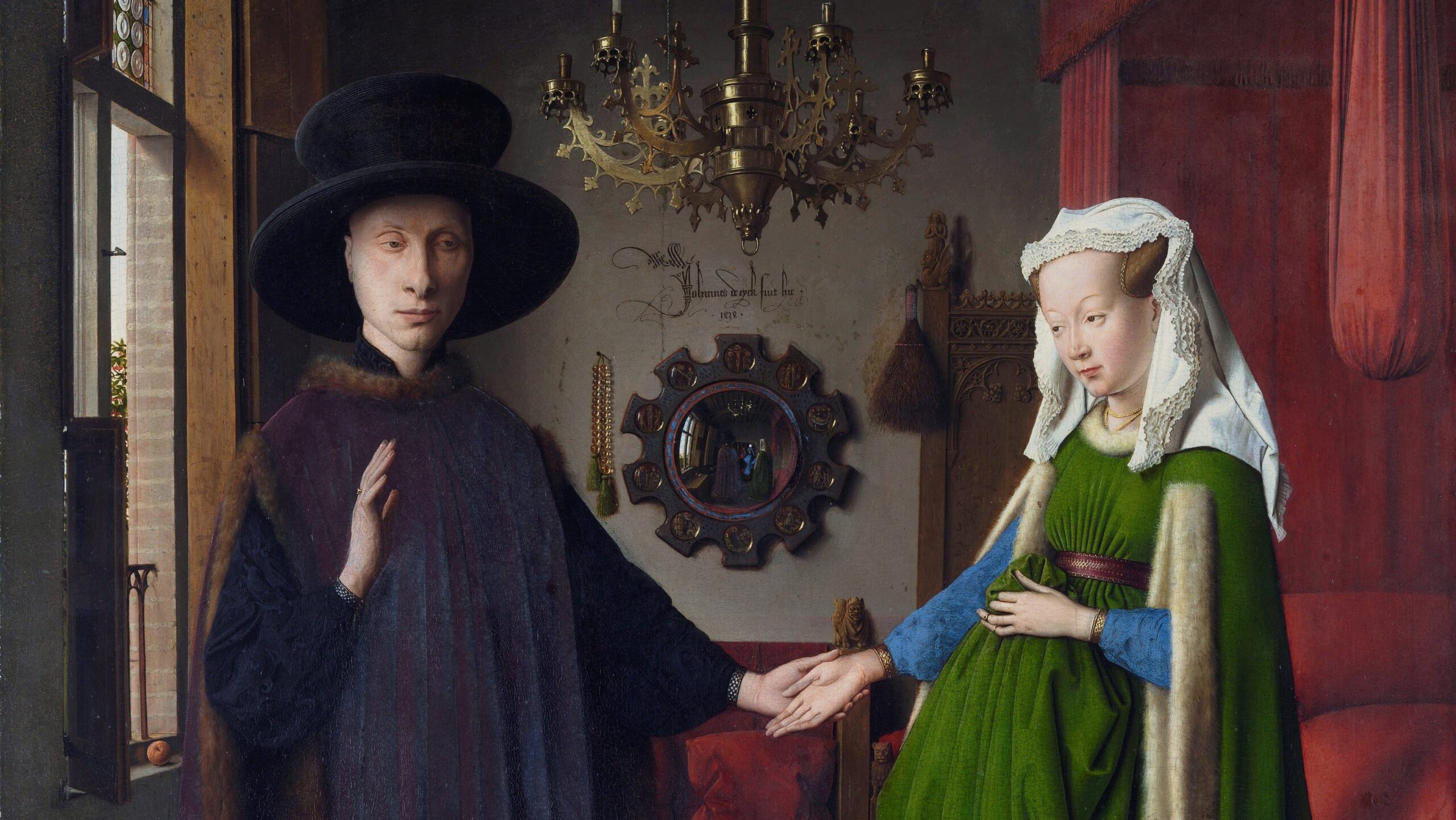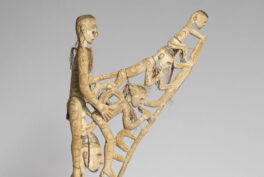The Artist
Jan van Eyck was born sometime before 1395 and died in 1441, he was buried in Bruges. He was not only an active painter in Burgundian Netherlands, but one of the most significant artists of the 15th century. His paintings, mostly portraits and religious subjects, represent a transition from medieval to Renaissance art. However, there is not much available information on his origins and artistic development.
His technique was incredibly innovative. He did not invent oil painting, as once rumored, but he did perfect use of it. Unlike egg paint (tempera), an oil medium takes longer to dry, allowing the artist to build up translucent layers of paint. This way a more detailed and glossy image can be produced and the realism of Van Eyck’s paintings relies precisely on the astonishing level of detail he was able to represent.
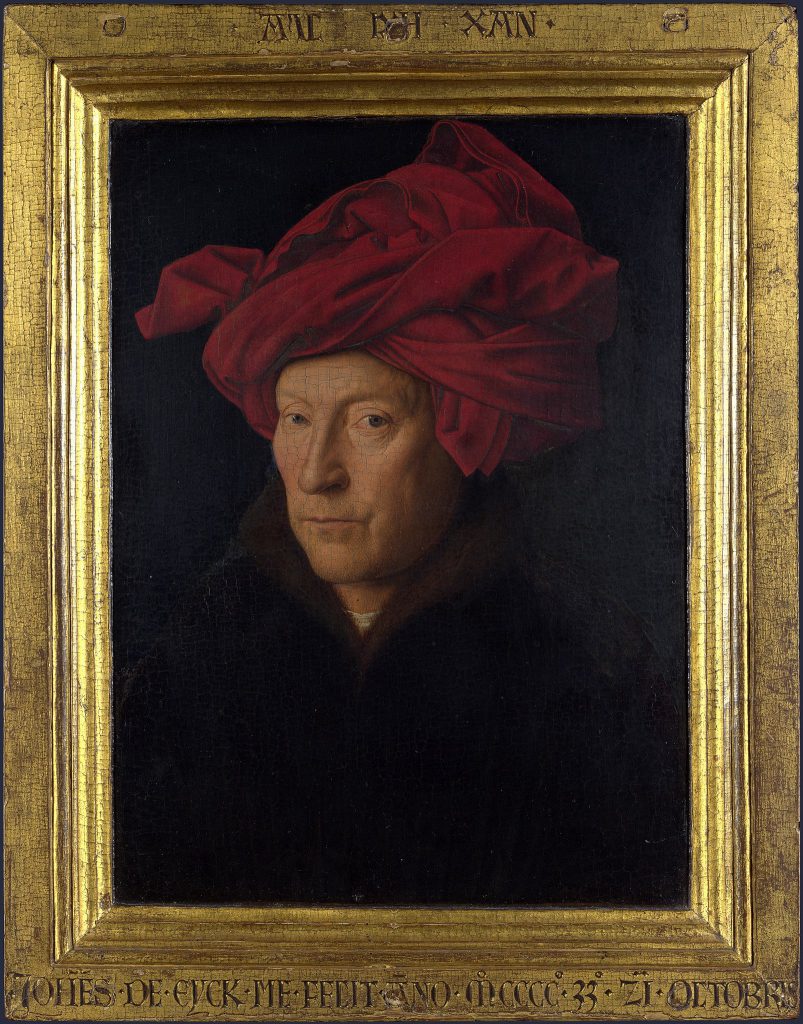
Jan van Eyck, Portrait of a Man (Self Portrait?), 1433, National Gallery, London, UK.
The Arnolfini Portrait
A man and a woman stand in a private room, their hands lightly touching in the space between them. They are richly dressed and their surroundings indicate their wealth and social status. The painted surface is relatively small (82 x 60 cm) but it holds a lot of information. In this double portrait, the artist’s detailed work doesn’t lie only in his technique, but also in every choice made for the composition – everything is carefully curated, from the architecture of the room to the colors used.
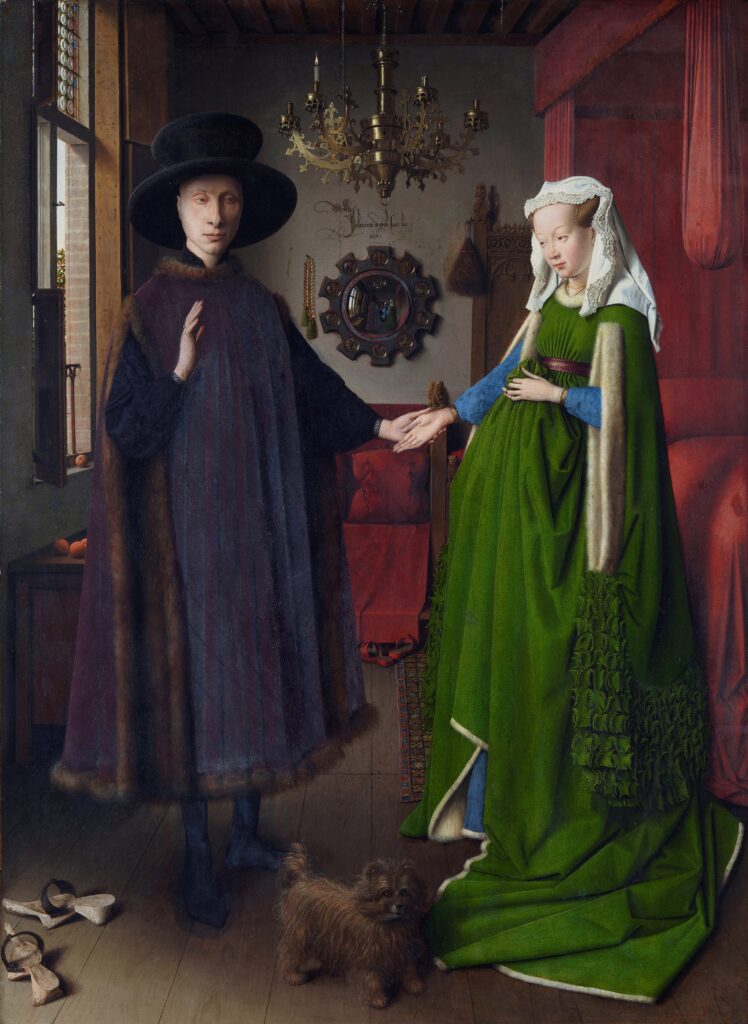
Jan van Eyck, Portrait of Giovanni(?) Arnolfini and his Wife, or Arnolfini Portrait, 1434, The National Gallery, London, UK.
For a long time, the painting was seen as the representation of a marriage ceremony (or of a couple soon to be married). Now it is understood that they are actually husband and wife, but their identities are still one of the many mysteries regarding this painting.
The male figure is most likely Giovanni di Nicolao di Arnolfini (also known as Giannino). The Arnolfinis were an extensive family of Italian merchants and many of the family members lived in Bruges at the time. In 1434, Giovanni would have been in his late thirties and the face in the Arnolfini Portrait resembles an identified portrait by Jan van Eyck from around a year later.
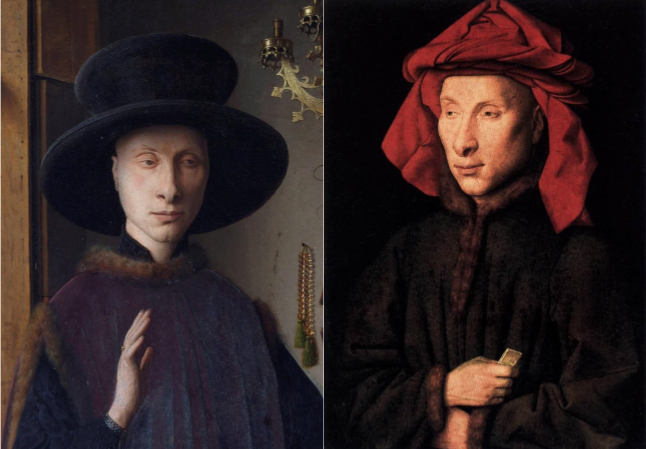
Left: Jan van Eyck, Portrait of Giovanni(?) Arnolfini and his Wife, 1434, The National Gallery, London, UK. Detail; Right: Jan van Eyck, Portrait of Giovanni Arnolfini, c. 1435, Gemäldegalerie, Berlin, Germany.
The identity of the woman, however, is a bigger mystery. For some time, it was thought that her name was Giovanna Cenami (Arnolfini’s second wife). More recently though, a document gave evidence that they only wed in 1447 (not only 13 years after this portrait was made but also six years after Van Eyck’s death). Giovanni Arnolfini married his first wife, Costanza Trenta, earlier in 1426, but she died a year before the portrait was painted.
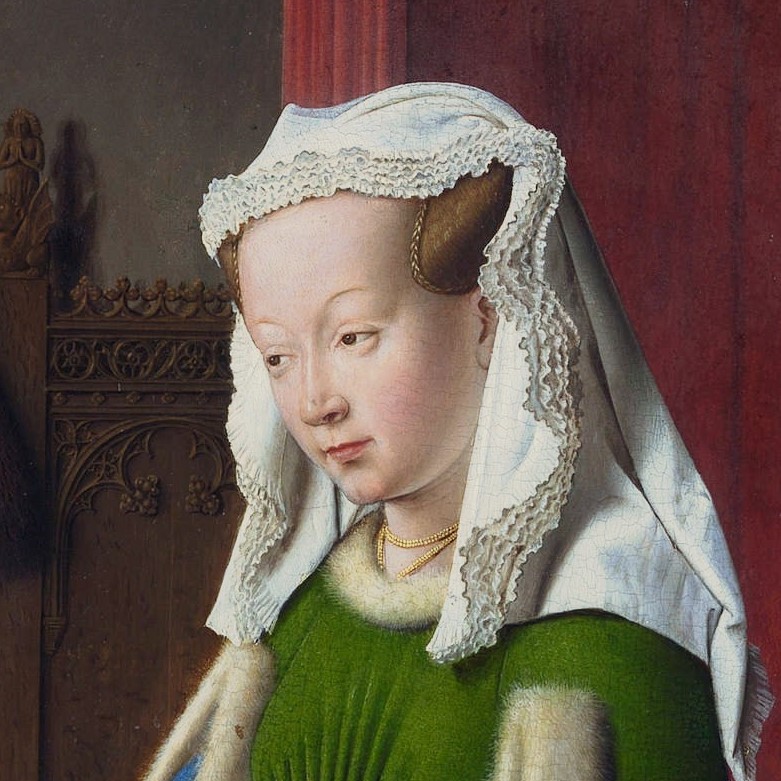
Jan van Eyck, Portrait of Giovanni(?) Arnolfini and his Wife, 1434, The National Gallery, London, UK. Detail.
It was not uncommon to order portraits of deceased people, though – so could that be the case here? It is not the prevailing interpretation but some art historians point to the dog positioned at her feet as evidence of this. Placing dogs at the feet of women in tomb effigies was a common practice since they were believed to accompany and guide the deceased in the afterlife. Therefore the dog’s presence in the painting could be a way of acknowledging her death – or it could simply serve as a common symbol of loyalty and fidelity.
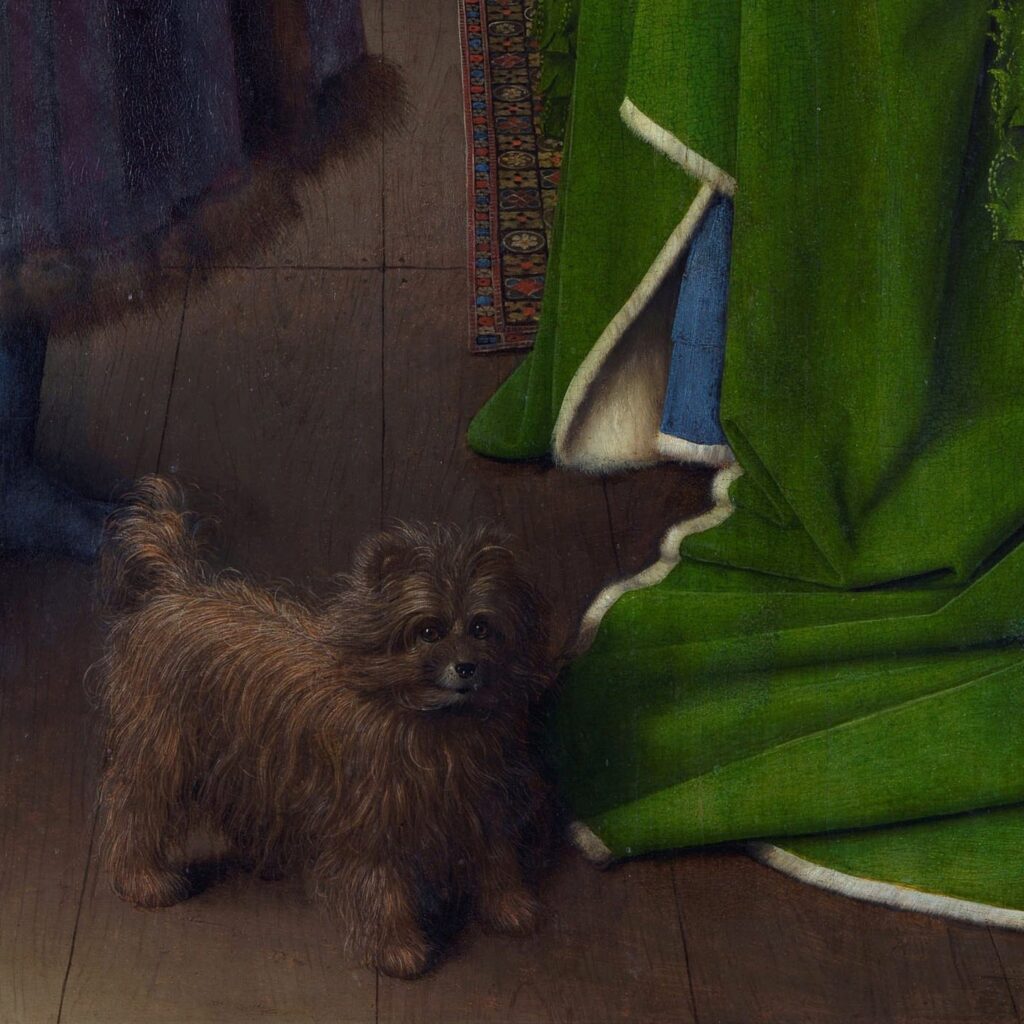
Jan van Eyck, Portrait of Giovanni(?) Arnolfini and his Wife, 1434, The National Gallery, London, UK. Detail.
Wealth And Status
Beyond the couple’s identity, what is the portrait depicting? In the social context of an emerging merchant middle-class, those who could afford it started to commission portraits to increase their social recognition – and that’s exactly what we see behind Jan van Eyck’s meticulous work.
A Refined Home
Starting with the room they occupy, what we see is the modern mansion of a wealthy merchant – comfortable and refined. It’s not a palace and they are not trying to pass as aristocracy – what they present is a restrained luxury. The house is of brick, with plastered walls and boarded floor. An intricate Oriental rug lies on the floor but no tapestries hang on the walls. The room is well-furnished and contains ornately carved furniture.
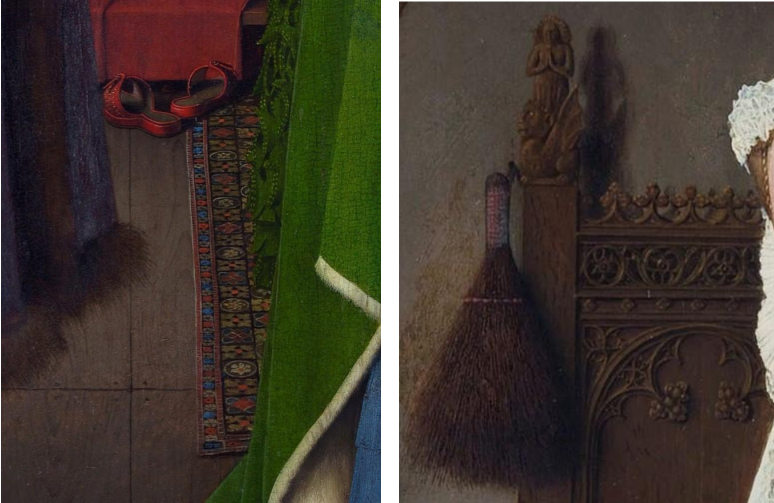
Jan van Eyck, Portrait of Giovanni(?) Arnolfini and his Wife, 1434, The National Gallery, London, UK. Detail.
On the right, a bed is covered in a luxurious red cloth and red cushions are scattered on the bedside chair and on the bench. On the left, an open window gives a view of a garden; above it, fancy stained glass windows (in red, blue, and green). Even the scattered oranges have a meaning behind them – the fresh fruit was extremely expensive at the time, so its presence indicates they could afford it.
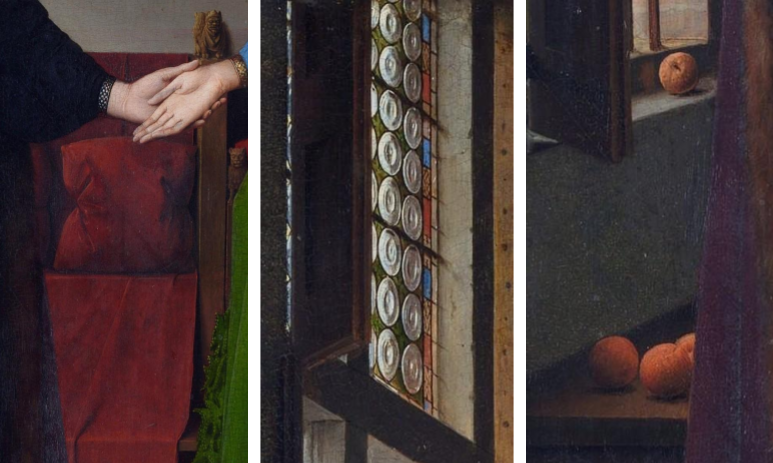
Jan van Eyck, Portrait of Giovanni(?) Arnolfini and his Wife, 1434, The National Gallery, London, UK. Details.
Fancy Wardrobe
The couple’s clothing adds to this idea of discreetly displayed wealth. Their clothes are expensive and fashionable, but not flashy. Neither one of them wears ostentatious jewelry with too much gold or precious stones (the woman wears two rings and a simple gold necklace, while the husband has one ring on his right hand). Just like the rest of the painting, the luxury is in the details which disclose their wealth without falling into the trap of too much pride or vanity.
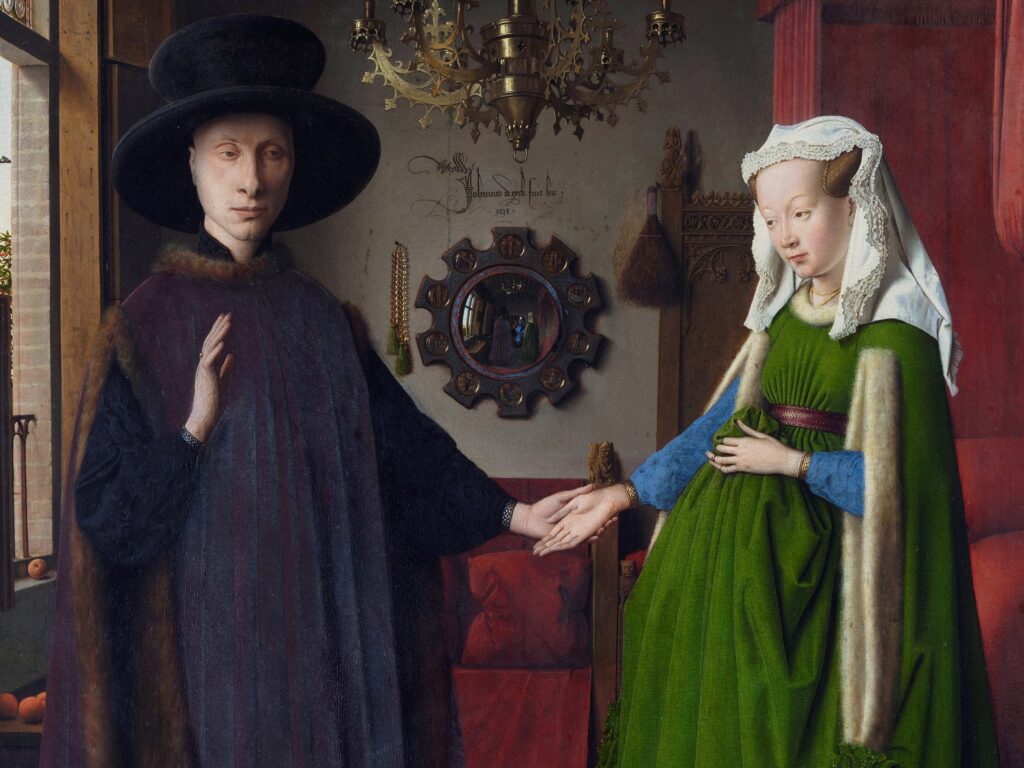
Jan van Eyck, Portrait of Giovanni(?) Arnolfini and his Wife, 1434, The National Gallery, London, UK. Detail.
The woman’s hair is fashionably caught up in modest horns and covered with a white veil. Her gown is green – one of the most expensive pigments at the time. Its size is impressive, and it would have required a lot of fabric (wool and white fur, also high-priced materials). Underneath it, is another expensive color: blue. She carries just enough of the color to show she can afford it, but without it being too much (since blue was mostly associated with royalty).
Against what might be the first impression, she is not pregnant. The way she holds the fabric of her clothes in front of her body gives it a volume that resembles pregnancy, but this was a usual way in which ladies held their gowns. It was a common pose in the Northern Renaissance context (seen as a sign of female decorum) and we can see it in other paintings from the same period.
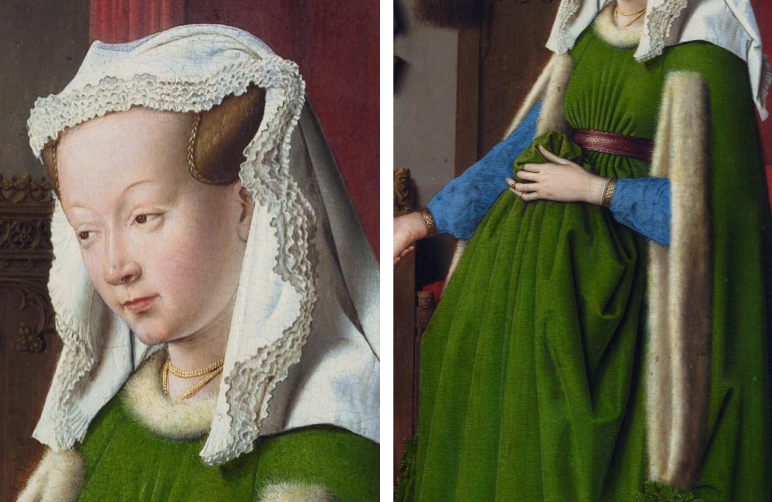
Jan van Eyck, Portrait of Giovanni(?) Arnolfini and his Wife, 1434, The National Gallery, London, UK. Detail.
The man’s clothing is dark with hints of blue, and the fabric is also heavy and fur-trimmed. It’s interesting to see how the artist represents the different materials in his garments: the structure of the man’s hat (plaited straw) is very different from the brown fur, just like the plain fabric and the silver cuffs have distinctive textures.
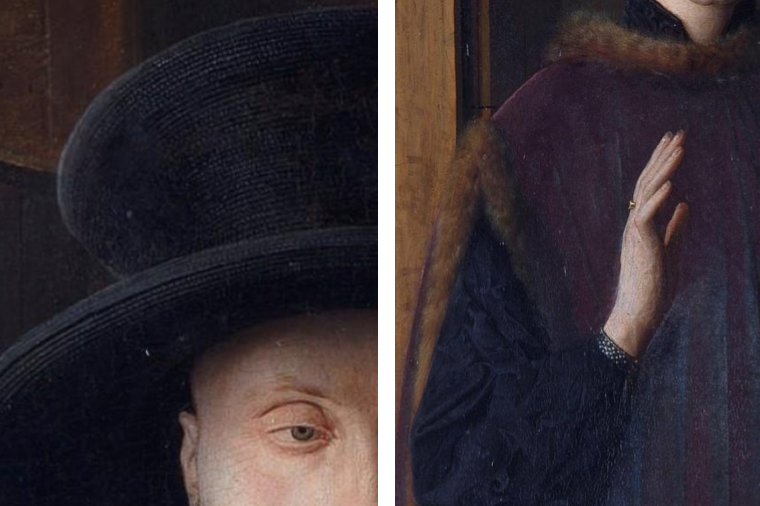
Jan van Eyck, Portrait of Giovanni(?) Arnolfini and his Wife, 1434, The National Gallery, London, UK. Details.
Religious Implications
The chandelier on the ceiling draws our attention for a couple of reasons: Van Eyck’s representation of such a detailed object is impressive, and the way the light reflects on the brass is also worth noticing. But religion and the expression of faith were important subjects at the time – and we can see this being represented in the chandelier. There is only one lit candle in it – this was a common way to symbolize devotion to only one God (the Christian God).
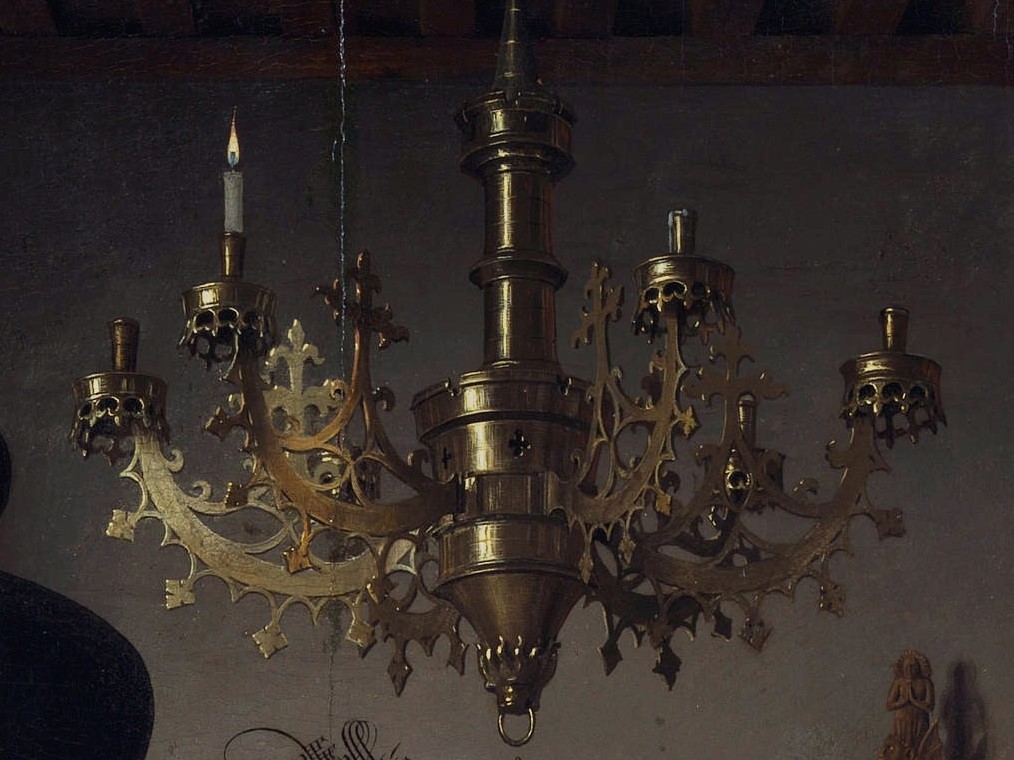
Jan van Eyck, Portrait of Giovanni(?) Arnolfini and his Wife, 1434, The National Gallery, London, UK. Detail.
Another religious element is the mirror, decorated with scenes from the Passion of Christ. The scenes that surround the mirror are not bigger than 1.5 cm each (even so, it’s possible to recognize each one of them). On the left, there are also some rosary beads – and by looking at them we’re once again amazed by Van Eyck’s technique. The green bristles are painted with precision, and not only can we see the light reflecting on the beads but also the thread passing through them.
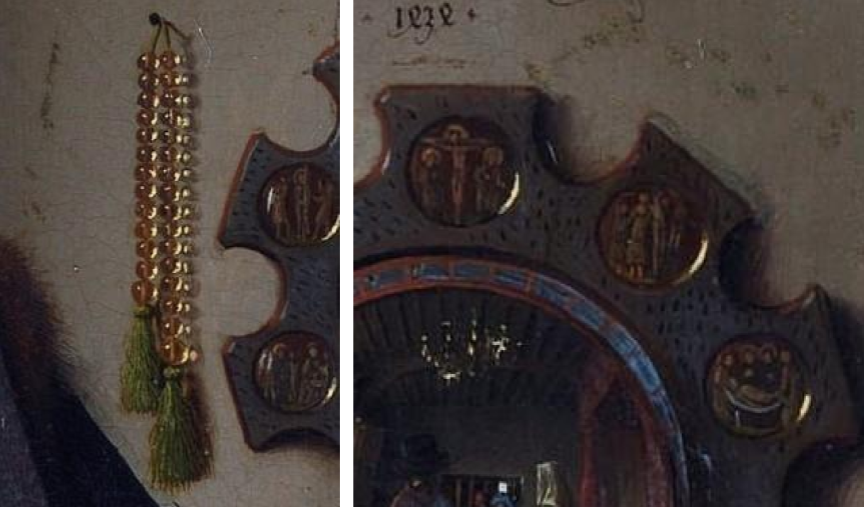
Jan van Eyck, Portrait of Giovanni(?) Arnolfini and his Wife, 1434, The National Gallery, London, UK. Details.
The Artist’s Presence
The convex mirror is one of the elements of the painting that prompts endless speculation. On the wall behind the couple, the large mirror (larger than would have been possible at the time) reflects not only the entire room and the back of the couple, but also the image of two men entering the room through a door – one dressed in red, the other dressed in blue. Above it, the artist’s signature in elaborate writing states: “Johannes de Eyck fuit hic. 1434” (meaning “Jan van Eyck was here. 1434”). Could Jan van Eyck be one of the men at the door? Is his signature asserting his presence in the scene he painted?

Jan van Eyck, Portrait of Giovanni(?) Arnolfini and his Wife, 1434, The National Gallery, London, UK. Detail.
Beneath the Arnolfini Portrait
Recent technical analyses have given us more knowledge on how the painting was made. We know, for example, that the under-drawing was done in stages. The two figures, the main furniture, and the basic architecture of the room were sketched first. Only later did Van Eyck add the terrier, the chandelier, and the chair.
He also altered the faces and the bodies of the couple in the following sketches. Among other modifications, he changed the position of the woman’s head and, most likely, softened and idealized the man’s features. Regarding his technique, we know he painted not only with the point of the brush but also with its handle. At times, he painted even with his own fingers (a thumbprint can be seen by the shadow of the dog’s leg).
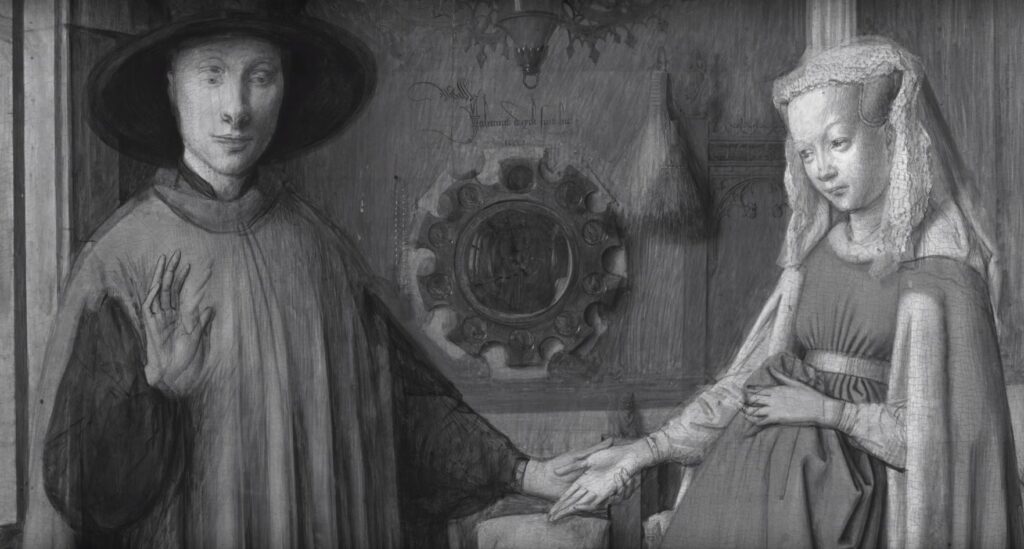
Jan van Eyck, Portrait of Giovanni(?) Arnolfini and his Wife, 1434, The National Gallery, London, UK. Infra-red Reflectogram detail. The National Gallery.
The Arnolfini Portrait presents us with valuable information and interesting elements to notice. However, it also raises a lot of questions we don’t have answers to – different interpretations and theories are constantly trying to find them, though. Some questions may be answered soon, as new evidence is uncovered and new studies come up, meanwhile other questions might always remain a mystery. Either way, Jan van Eyck has certainly left us with one of the most intriguing paintings in the history of art.
P.S. Here you can see a macro-photograph of the Arnolfini Portrait in supreme quality, provided by Closer to Van Eyck Research Project that investigates the artist’s creative process!
